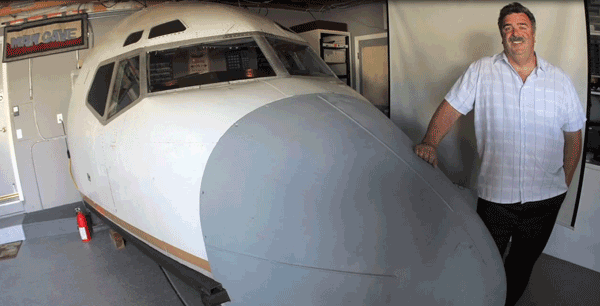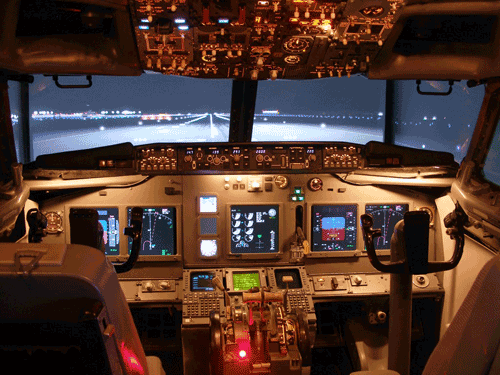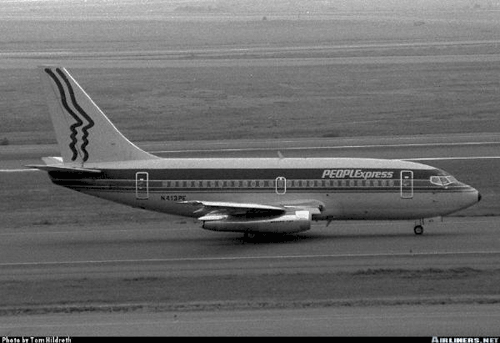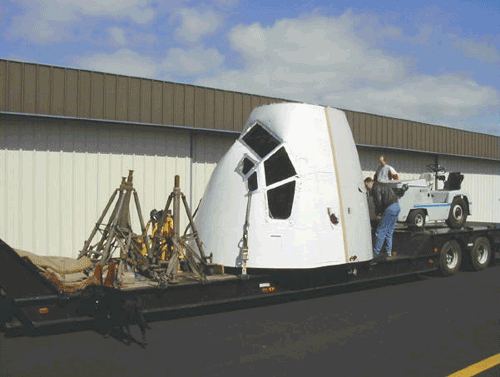Hobbyist uses nose of Boeing 737 to build flight simulator in garage
There are flight enthusiasts, and then there’s James Price
Meet James Price: air traffic controller and licensed pilot. He loves flying so much that he built a flight simulator in his garage . . . using the nose of a retired Boeing 737 cockpit!

James Price standing next to his flight simulator.
Price bought the nosecone section and cockpit of a 1969 Boeing 737-100 back in 2000, and has spent the last 12 years retrofitting it into his own personal flight simulator.

Interior view of James Price’s garage-stationed flight simulator.
Turning a dream into reality
Price’s dream of building a full-sized flight simulator began nearly two decades ago when he joined an online group of flight simulator hobbyists. An air traffic controller and private pilot, he’s never actually flown a jet but dreams of one day there being an opportunity for him to do so. Until that day arrives, however, he figures he might as well practice. So, he decided to build his own jet simulator, and immediately started collecting Boeing 737 parts and building mock cockpits.
This casual hobby turned full-fledged dedication when he went to a scrap yard with fellow flight enthusiast and friend, Matt Ford. The two were there to look at a bunch of retired airplanes to see if any parts were available for picking, but they both ended up walking away with actual cockpits: Ford bought a Boeing 737 nose to use at his home in Dallas, and shortly after their trip Price decided to get on board, too, paying $1,500 for the shell of a retired Continental Airline 737 nose section.

The plane from which the nosecone section was taken.
Price had to hire a semi-truck to move the nose, as it weighed nearly 2,500 pounds. It went straight to his hangar at Livermore Municipal Airport (home to Price’s single-engine Piper Arrow), where it stayed for a number of years while he tinkered with it, adding parts that he’d been collecting for the last 20 years to modernize it and give the space a real-jet feeling.

Pilot’s seat.
While Boeing parts are expensive and often hard to find, the one thing that Price had going for him is that many of them, like say, control columns and Korry lights, are interchangeable between the Boeing 727 and Boeing 737. What’s more, the 727 resale parts are actually more common than the 737’s, and they’re cheaper, too.
In total, Price has spent about $150,000 on this project. Items updated included new seats, throttles, dual flight controls for the pilot and co-pilot, and a brand new panel with completely modern instruments.

Close-up of control panel.
One unfortunate incident occurred, however, when the cockpit was ready to be moved to Price’s home in Pleasanton, California: He had to shave 4 feet off the nose and tear out part of his three-car garage just to get it to fit.

The shaved down nosecone being transferred to Price’s home.
A wild ride
The nose is surrounded by three full-sized projection screens hanging from the ceiling. They display a flight simulator program on the screens, giving Price and his co-pilot a real-flight experience. While the cockpit is stationery, the on-screen moving images trick the brain into feeling like the pilot is actually airborne.
Price programmed the flight simulator with Ford. They included terrain and scenery from all over the world and even went so far as to include a complete weather system with real-time weather updates via the Internet. Check out the video below – you’ll see a part where he’s flying in snow at night:
Flying in bad weather is not the only stressful situation that Price included in his simulator: He also scripted what it would be like to fly a jet when an engine fails or there’s a fire on board, and practices avoiding a crash by crash-landing the plane on land or soaring across and onto the ocean.
Looking ahead
This has been a lifelong hobby of Price and it’s encouraging for hobbyists everywhere when one of our own successfully turns their pet project into something this amazing.
True to his hobbyist roots, Price is quick to say that this is not the end of the road for him and his desire to build flight simulators — he figures to be tinkering with this new toy for years to come.
Follow Price’s progress and learn more about the project at his website: 737simguy.com ■
Video via BayAreaNewsGroup.com
Advertisement
Learn more about Electronic Products Magazine





